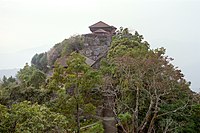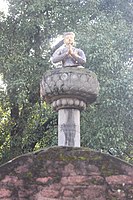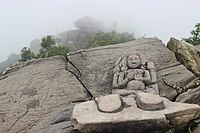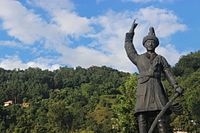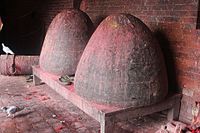Gorkha Kingdom
Kingdom of Gorkha गोरखा राज्य Gōrakhā Rājya | |||||||||
|---|---|---|---|---|---|---|---|---|---|
| 1559–1768 | |||||||||
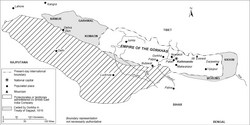 Territory, expansion and vassals states of Gorkha Empire. | |||||||||
| Status | Confederation[1] later Kingdom | ||||||||
| Capital | Gorkha | ||||||||
| Common languages | Khas (later Nepali) Newar[2][3][4][a] | ||||||||
| Religion | Hinduism | ||||||||
| Government | Monarchy | ||||||||
| Māhārājādhirāj | |||||||||
• 1559–1570 | Dravya Shah (first) | ||||||||
• 1743–1768 | Prithvi Narayan Shah (last) | ||||||||
| Sardar | |||||||||
• 1767–1771 | Ram Krishna Kunwar (first and last) | ||||||||
| History | |||||||||
• Established | 1559 | ||||||||
• Disestablished | 1768 | ||||||||
| Currency | Mohar | ||||||||
| |||||||||
| Today part of | Nepal | ||||||||
| History of Nepal |
|---|
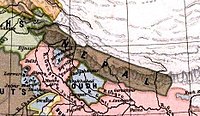 |
|
|
The Gorkha Kingdom,[b] also known as the Gorkha Confederation[c] or the Gorkha Empire,[d] was a member of the Chaubisi rajya, a confederation of 24 states, located at the intersection of Himalayas and the Indian subcontinent. In 1743, the kingdom began a campaign of military expansion, annexing several neighbors and becoming present-day Nepal.[1]
The Gorkha Kingdom extended to the Marshyangdi River in the west, forming its border with the Kingdom of Lamjung. To the east, the kingdom extended to the Trishuli River, forming its border with the Nepal Mandala.[6] The Gorkha Kingdom was established in 1559 CE by Prince Dravya Shah, the second son of King Yasho Brahma Shah of Lamjung. Dravya Shah replaced the Magar King Mansingh Khadka Magar who previously ruled the region.[7]
Origin and history
[edit]The founding of the gorkhas did not escape the influence of the Newars. One of the earliest Shah rulers was Rishi-raj Rana-Ji, of the Lunar dynasty (A Newars descendant). He was made the ruler of Chittorgarh and received the title of Bhattarak.[8] The lunar dynasty remained in power for thirteen generations. Then, the Muslim Yavanas took power. The Bhattarak had to abdicate and could only retain his caste family name, Rana-ji. The rajas were titled Rana-Ji for four generations and Rana-ji Rava for a further seventeen generations.
Akbar, the Mughal emperor, (1542-1605) wished to marry the daughter of Fatte Sinha Rana-Ji Rava. Akbar was refused because he was not a Hindu but from a different religion (namely Islam). This decision led to the war. Many Rajputs, including Fatte Sinha Rana-ji Rava, were killed. The survivors of the war were led by Udaybam Rana-Ji Rava. They founded a settlement called Udaipur.[8]
Manmath Rana-Ji Rava went to Ujjain. His son Bhupal Ranaji Rao went to Ridi[citation needed] in the northern hills in 1495 CE (Saka Era 1417), to Sargha, and then to Khium in Bhirkot. There, he cultivated the land. The new ruler of Khium had two sons, Kancha and Micha.[8] Their bartabandha (the taking of the Bharmanical thread) was performed. Plans for the boys to marry the daughters of the Raghuvanshi Rajputs were made. Kancha, the elder son, went to Dhor. He conquered Magarat and reigned over Garhon, Sathum and Birkot. Micha, the younger son, went to Nuwakot in the far west and became ruler there.[8]
From Micha, a dynasty of seven rajas commenced in Nuwakot. Kulamandan became ruler of Kaski, displacing the local Gurung king. He was favoured and became Shah and succeeded his father. Kalu, the second son was sent to Dura Danda in Lamjung at the people's request to become their king. Kalu was killed by the Sekhant tribe, who were the ancestors of present-day Gurungs. In the 1500s, another son, Yasobramha, became the ruler of Lamjung after he compromised with the Gurungs.[8] The second son of Yasobramha, Dravya Shah conquered the kingdom of Ligligkot from Magar king Dalshur Ghale Magar. Gangaram Rana Magar also helped Drabya Shah. At that time in Gorkha, Uppallokot (fort in the upper part) area and Tallokot (fort in the lower part) area of Gorkha were ruled by Magar King Mansingh Khadka Magar and king Dalshur Ghale Magar. Khadka Magar is a sub-clan of Rana Magar clan and (Ghale Magar) sub-clan of saru-Thapa-Magar clan. After Dravya Shah captured Liglig-kot from king Dalshur Ghale Magar, he captured Gorkha-kot, another Magarat area from the Magar King Mansingh Khadka Magar in 1559 CE and named the newly found kingdom Gorkha.[9] The ancient name Gor-kha is derived from Gorakhnath.[10]
-
The old king's Darbar at Gorkha
-
Mohar of Gorkha king Prithvi Narayan Shah dated Saka Era 1685 (1763 CE)
List of kings of Gorkha
[edit]
The following is a list of the ten kings of the Gorkha principality:[citation needed]
| Name | Lifespan | Reign start | Reign end | Notes | Family | Image |
|---|---|---|---|---|---|---|
Dravya Shah
| died 1570 | 1559 | 1570 | Son of Yasho Brahma Shah | Shah | |
Purna Shah
| died 1605 | 1570 | 1605 | Son of Dravya Shah | Shah | |
Chatra Shah
| died 1609 (heirless) | 1605 | 1609 | First son of Purna Shah | Shah | |
Ram Shah
| died 1636 | 1609 | 1633 (abdicated) | Second son of Purna Shah adopted title of Svasti Sri Giriraj | Shah |  |
Dambar Shah
| died 1645 | 1633 | 1645 | Son of Ram Shah | Shah | |
Krishna Shah
| died 1661 | 1645 | 1661 | Son of Dambar Shah | Shah | |
Rudra Shah
| died 1673 | 1661 | 1673 | Son of Krishna Shah | Shah | |
Prithvipati Shah
| died 1716 | 1673 | 1716 | Son of Rudra Shah | Shah | |
Nara Bhupal Shah
| 1697 – 3 April 1743 | 1716 | 1743 | Grandson of Prithvipati Shah and Son of Prince Birbhadra Shah | Shah | |
Prithvi Narayan Shah
| 11 January 1723[citation needed] – 15 January 1775 (aged 52) | 1743 | 25 September 1768 | Son of Nara Bhupal Shah | Shah |  |
Expansion campaign
[edit]From 1736, the Gorkhalis engaged in a campaign of expansion begun by King Nara Bhupal Shah, which was continued by his son, King Prithvi Narayan Shah and grandson Prince Bahadur Shah. Over the years, they conquered huge tracts of land to the east and west of Gorkha.[11][12]
Among their conquests, the most important and valuable acquisition was the wealthy Newar confederacy of Nepal Mandala centered in the Kathmandu Valley. Starting in 1745, the Gorkhalis mounted a blockade in a bid to starve the population into submission, but the inhabitants held out.
The Newars appealed to the British East India Company to help, and in 1767, it sent an expedition under Captain Kinloch which ended in failure.[13] The three Newar capitals of Kathmandu, Lalitpur and Bhaktapur fell to the Gorkhalis between 1768 and 1769. The Gorkhali king subsequently moved his capital to Kathmandu.[14]
In 1788, the Gorkhalis turned their attention north and invaded Tibet.[15] They seized the border towns of Kyirong and Kuti, and forced the Tibetans to pay an annual tribute. When the Tibetans stopped paying it, the Gorkhalis invaded Tibet again in 1791 and plundered the Tashilhunpo Monastery in Shigatse. This time the Chinese army came to Tibet's defence and advanced close to Kathmandu but could not achieve success due to strong counterattack.[16] The anxious Bahadur Shah asked for 10 howitzer mountain guns from the British East India Company. Captain William Kirkpatrick arrived in Kathmandu, however the deal was not made due to unfavorable circumstances for the Gorkhalis.[17] Eventually, the Fu Kanggan was keen to protect his army and the war being resultless was concluded by signing a peace treaty at Betrawati.[16][18][19]
A later Nepalese–Tibetan War was fought from 1855 to 1856 in Tibet between the forces of the Tibetan government (Ganden Phodrang, then under administrative rule of the Qing dynasty) and the invading Nepalese army, resulting in the victory of Nepal.[16]
The Gorkha dominion reached its height at the beginning of the 19th century, extending all along the Himalayan foothills from Kumaon and Garhwal in the west to Sikkim in the east. They were made to return much of the occupied territories after their defeat in the Anglo-Nepalese War (1814–1816).[20][21]
Gorkha to Nepal
[edit]

The Gorkha dominion continued to be known as "Gorkha Rajya" (lit. 'Gorkha Kingdom') until the beginning of the 20th century. Historically, the name 'Nepal' referred mainly to Kathmandu valley, the homeland of the Newars. Since the 1930s, the state began using it to refer to the entire country and 'Nepal Khaldo' (Nepal Valley) became 'Kathmandu Valley'.[22][23] The name Gorkha Sarkar (meaning Gorkha government) was also changed to Nepal government.
Similarly, the Gorkhali language was renamed as Nepali in 1933.[24] The term Gorkhali in the former national anthem entitled "Shreeman Gambhir" was changed to Nepali in 1951.[25] The government newspaper, launched in 1901, is still known as Gorkhapatra (meaning Gorkha gazette).
The Shah dynasty ruled Nepal until 2008 when it became a republic following a people's movement.[26] Today, Gorkha District, roughly corresponding to the old kingdom, is one of the 77 administrative districts of Nepal.
Gurkhas
[edit]
Not to be confused with the inhabitants of the old Gorkha Kingdom only, the Gurkhas are also military units in the British or the Indian army (where they are known as Gorkhas) enlisted in Nepal and India. Their history goes back to the Anglo-Gorkha War and the Sugauli Treaty of 1816. It allowed the British East India Company to recruit men from the Gorkha kingdom hills to serve as mercenaries.
During World War II (1939–45), a total of 250,280 Gurkhas served in 40 battalions, plus eight Nepalese Army battalions, plus parachute, training, garrison, and porter units. They earned 2,734 bravery awards, and suffered around 32,000 casualties in all theatres.[27]
Gallery
[edit]-
Metal Window
-
Stone history
-
Gorkha Durbar
-
King Prithavi Pal
-
Image of Goddess & Gorkha Palace
-
Gorkha Tallo Durbar
-
Shree Panch Bada Maharajadhiraj Prithavi Narayan Shah Dev
-
Nepali Cannon
-
Nagada
See also
[edit]- Gurkha
- Battle of Kathmandu
- Kingdom of Nepal
- List of Hindu empires and dynasties
- Shah dynasty
- Rana dynasty
Notes
[edit]- ^ Newari continued to remain in official use in Shah dynasty as shown by the 1775 treaty with Tibet, which was written in Newari. Newari remained as the administration and official language of Nepal till the early 19th centuries. Later since 1906, official documents written in Newari were declared illegal. Since then the use of the language for administration and literary purposes was forbidden.[5]
- ^ Nepali: गोरखा राज्य, romanized: Gōrakhā Rājya, IPA: [ɡoɾkʰa ɾad͡zjʌ]
- ^ Nepali: गोर्खा महासंघ, romanized: Gōrkhā Mahāsangha, IPA: [ɡoɾkʰa ma̤ːsʌŋɡʱʌ]
- ^ Nepali: गोर्खा साम्राज्य, romanized: Gōrkhā Sāmrājya, IPA: [ɡoɾkʰa samɾad͡zjʌ]
References
[edit]- ^ a b Hamilton, Francis Buchanan (1819). An Account of the Kingdom Of Nepal and of the Territories Annexed to This Dominion by the House of Gorkha. Edinburgh: Longman. Archived from the original on 13 November 2012. Retrieved 12 January 2013. Page 237.
- ^ Nepal Bhasa Sahityaya Itihas: History of Nepalbhasa Literature.Tuladhar, Prem Shanti (2000). Kathmandu: Nepal Bhasa Academy. ISBN 99933-56-00-X. Page 37: "The early new rulers cultivated Newari language. Kings Prithvi Narayan Shah, Rana Bahadur and Rajendra Bikram Shah composed poetry and wrote many plays in Newari".
- ^ Levy, Robert I. (1990) Mesocosm: Hinduism and the Organization of a Traditional Newar City in Nepal. Delhi: Motilal Banarsidass Publishers. ISBN 81-208-1038-4. Page 15:"Following the advent of the Shahs, the Gorkhali language became the court language, and Newari was replaced as the language of administration".
- ^ Malla, kamal. History of the Nepal. Kathmandu, Nepal: Rolwaling press. p. 155
- ^ Lienhard 1992, p. 3.
- ^ Kirkpatrick, Colonel (1811). An Account of the Kingdom of Nepaul. London: William Miller. Retrieved 12 January 2013. Page 123.
- ^ Marie Lecomte-Tilouine (Senior Researcher, Anthropology) CNRS, Paris, France. "The Enigmatic Pig: On Magar Participation in the State Rituals of Nepal, pp. 81-120 in M. Lecomte-Tilouine: Hindu Kingship, Ethnic Revival and Maoist Rebellion in Nepal. Delhi: Oxford University Press, "Collected Essays", 2009, 294 p". Oxford University Press.
{{cite web}}: CS1 maint: multiple names: authors list (link) - Page 85, p.95 - ^ a b c d e Daniel Wright, History of Nepāl, Cambridge University Press, 1877, Nepal. Chapter X, page 273
- ^ Marie Lecomte-Tilouine (Senior Researcher, Anthropology) CNRS, Paris, France. "The Enigmatic Pig: On Magar Participation in the State Rituals of Nepal, pp. 81-120 in M. Lecomte-Tilouine: Hindu Kingship, Ethnic Revival and Maoist Rebellion in Nepal. Delhi: Oxford University Press, "Collected Essays", 2009, 294 p". Oxford University Press.
{{cite web}}: CS1 maint: multiple names: authors list (link) pp. 95- 96 - ^ "Bringing Aid To Gorkha's Poor | Features | ECS Nepal - The Nepali Way". ecs.com.np. Archived from the original on 2022-01-16. Retrieved 2017-04-23.
- ^ Hamilton, Francis Buchanan (1819). An Account of the Kingdom Of Nepal and of the Territories Annexed to This Dominion by the House of Gorkha. Edinburgh: Longman. Archived from the original on 13 November 2012. Retrieved 6 January 2013. Page 7.
- ^ Northey, William Brook and Morris, Charles John (1928). The Gurkhas: Nepal-Their Manners, Customs and Country. Asian Educational Services. ISBN 9788120615779. Pages 30-31.
- ^ Marshall, Julie G. (2005). "Gurkha Conquest of Nepal and the Kinloch and Logan Missions". Britain And Tibet 1765-1947. Routledge. p. 39. ISBN 9780415336475.
- ^ Hamilton, Francis Buchanan (1819). An Account of the Kingdom Of Nepal and of the Territories Annexed to This Dominion by the House of Gorkha. Edinburgh: Longman. Archived from the original on 13 November 2012. Retrieved 15 January 2013. Page 7.
- ^ Marshall, Julie G. (2005). "Nepal 1788-1903". Britain And Tibet 1765-1947. Routledge. p. 57. ISBN 9780415336475.
- ^ a b c "Nepalese Army | नेपाली सेना". Archived from the original on 2016-12-20. Retrieved 2017-02-05.
- ^ Kirkpatrick, Colonel (1811). An Account of the Kingdom of Nepaul. London: William Miller. Retrieved 11 February 2013.
- ^ Boulnois, L. "Chinese Maps and Prints on the Tibet-Gorkha War of 1788-92" (PDF). Kailash. p. 86. Archived (PDF) from the original on 24 February 2021. Retrieved 21 January 2013.
- ^ "The Enclosing of Nepal". U.S. Library of Congress. Archived from the original on 23 June 2011. Retrieved 21 January 2013.
- ^ Pradhan, Kumar (1991). The Gorkha conquests: the process and consequences of the unification of Nepal, with particular reference to eastern Nepal. Oxford University Press. ISBN 978-0-19-562723-7. Retrieved 6 February 2013.
- ^ Jha, Pranab Kumar (1985). History of Sikkim, 1817–1904: Analysis of British Policy and Activities. O.P.S. Publishers. p. 11. ASIN B001OQE7EY.
- ^ Planet, Lonely. "History of Nepal - Lonely Planet Travel Information". www.lonelyplanet.com. Archived from the original on 2017-09-22. Retrieved 2016-05-08.
- ^ Bindloss, Joseph (2010-09-15). Nepal 8. Lonely Planet. ISBN 9781742203614.
- ^ Lienhard, Siegfried (1992). Songs of Nepal: An Anthology of Nevar Folksongs and Hymns. New Delhi: Motilal Banarsidas. p. 3. ISBN 81-208-0963-7.
- ^ "The kings song". Himal Southasian. June 2003. Archived from the original on 25 October 2012. Retrieved 3 April 2012.
- ^ "Nepal's Gorkha kingdom falls". The Times of India. 2 June 2008. Archived from the original on 11 April 2013. Retrieved 11 February 2013.
- ^ Parker, John (2005). The Gurkhas: The Inside Story of the World's Most Feared Soldiers. Headline Book Publishing. ISBN 978-0-7553-1415-7.



